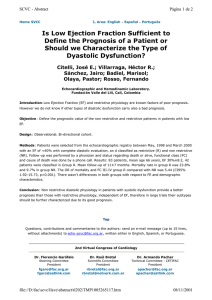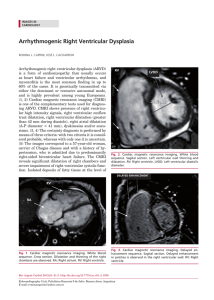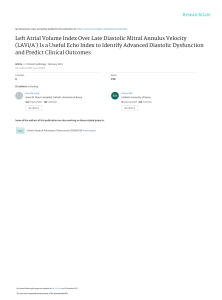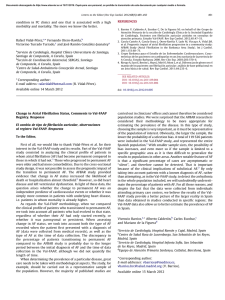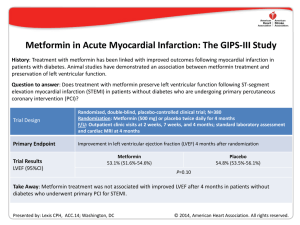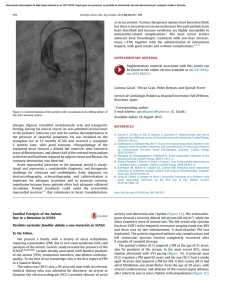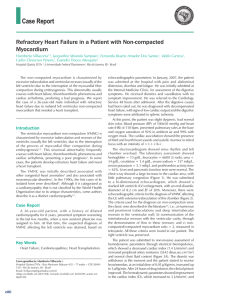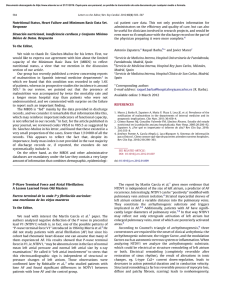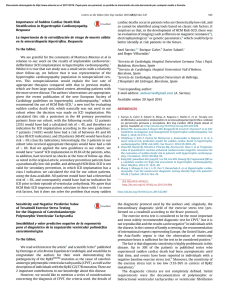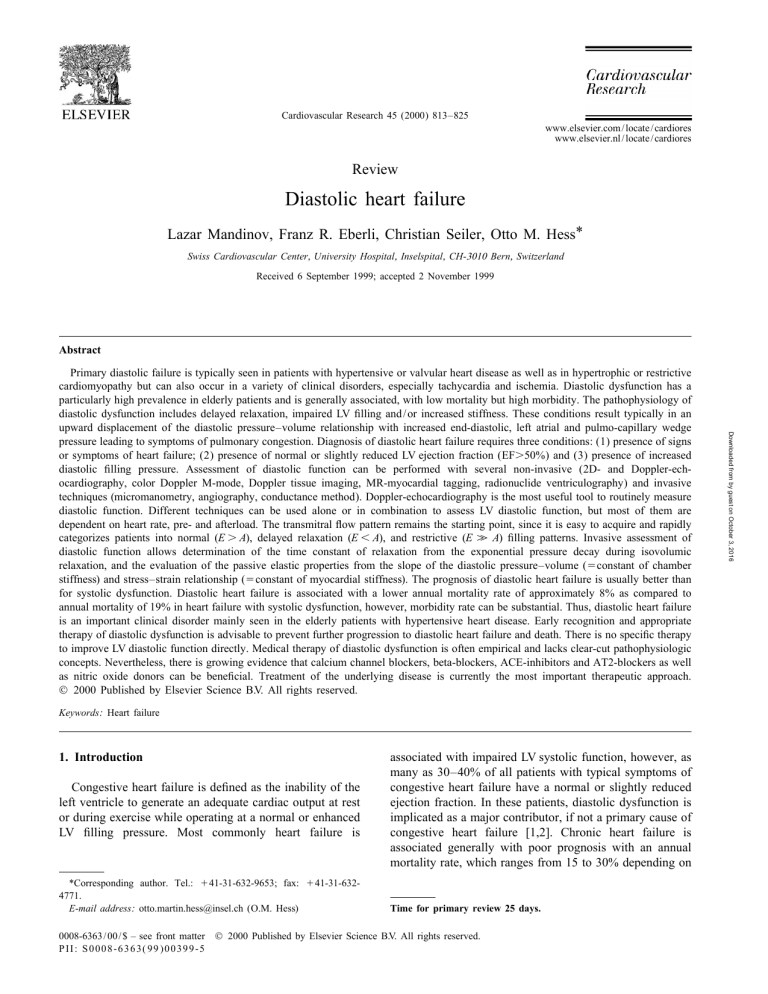
Cardiovascular Research 45 (2000) 813–825 www.elsevier.com / locate / cardiores www.elsevier.nl / locate / cardiores Review Diastolic heart failure Lazar Mandinov, Franz R. Eberli, Christian Seiler, Otto M. Hess* Swiss Cardiovascular Center, University Hospital, Inselspital, CH-3010 Bern, Switzerland Received 6 September 1999; accepted 2 November 1999 Abstract Keywords: Heart failure 1. Introduction Congestive heart failure is defined as the inability of the left ventricle to generate an adequate cardiac output at rest or during exercise while operating at a normal or enhanced LV filling pressure. Most commonly heart failure is *Corresponding author. Tel.: 141-31-632-9653; fax: 141-31-6324771. E-mail address: otto.martin.hess@insel.ch (O.M. Hess) associated with impaired LV systolic function, however, as many as 30–40% of all patients with typical symptoms of congestive heart failure have a normal or slightly reduced ejection fraction. In these patients, diastolic dysfunction is implicated as a major contributor, if not a primary cause of congestive heart failure [1,2]. Chronic heart failure is associated generally with poor prognosis with an annual mortality rate, which ranges from 15 to 30% depending on Time for primary review 25 days. 0008-6363 / 00 / $ – see front matter 2000 Published by Elsevier Science B.V. All rights reserved. PII: S0008-6363( 99 )00399-5 Downloaded from by guest on October 3, 2016 Primary diastolic failure is typically seen in patients with hypertensive or valvular heart disease as well as in hypertrophic or restrictive cardiomyopathy but can also occur in a variety of clinical disorders, especially tachycardia and ischemia. Diastolic dysfunction has a particularly high prevalence in elderly patients and is generally associated, with low mortality but high morbidity. The pathophysiology of diastolic dysfunction includes delayed relaxation, impaired LV filling and / or increased stiffness. These conditions result typically in an upward displacement of the diastolic pressure–volume relationship with increased end-diastolic, left atrial and pulmo-capillary wedge pressure leading to symptoms of pulmonary congestion. Diagnosis of diastolic heart failure requires three conditions: (1) presence of signs or symptoms of heart failure; (2) presence of normal or slightly reduced LV ejection fraction (EF.50%) and (3) presence of increased diastolic filling pressure. Assessment of diastolic function can be performed with several non-invasive (2D- and Doppler-echocardiography, color Doppler M-mode, Doppler tissue imaging, MR-myocardial tagging, radionuclide ventriculography) and invasive techniques (micromanometry, angiography, conductance method). Doppler-echocardiography is the most useful tool to routinely measure diastolic function. Different techniques can be used alone or in combination to assess LV diastolic function, but most of them are dependent on heart rate, pre- and afterload. The transmitral flow pattern remains the starting point, since it is easy to acquire and rapidly categorizes patients into normal (E . A), delayed relaxation (E , A), and restrictive (E 4 A) filling patterns. Invasive assessment of diastolic function allows determination of the time constant of relaxation from the exponential pressure decay during isovolumic relaxation, and the evaluation of the passive elastic properties from the slope of the diastolic pressure–volume (5constant of chamber stiffness) and stress–strain relationship (5constant of myocardial stiffness). The prognosis of diastolic heart failure is usually better than for systolic dysfunction. Diastolic heart failure is associated with a lower annual mortality rate of approximately 8% as compared to annual mortality of 19% in heart failure with systolic dysfunction, however, morbidity rate can be substantial. Thus, diastolic heart failure is an important clinical disorder mainly seen in the elderly patients with hypertensive heart disease. Early recognition and appropriate therapy of diastolic dysfunction is advisable to prevent further progression to diastolic heart failure and death. There is no specific therapy to improve LV diastolic function directly. Medical therapy of diastolic dysfunction is often empirical and lacks clear-cut pathophysiologic concepts. Nevertheless, there is growing evidence that calcium channel blockers, beta-blockers, ACE-inhibitors and AT2-blockers as well as nitric oxide donors can be beneficial. Treatment of the underlying disease is currently the most important therapeutic approach. 2000 Published by Elsevier Science B.V. All rights reserved. 814 L. Mandinov et al. / Cardiovascular Research 45 (2000) 813 – 825 2. Diagnostic approach to diastolic heart failure The diagnosis of diastolic heart failure requires three conditions to be simultaneously satisfied [15]: (1) presence of signs and symptoms of heart failure; (2) presence of normal or only slightly reduced LV ejection fraction (EF. 50%) and (3) presence of increased diastolic pressure or impaired filling caused by delayed isovolumic relaxation or elevated stiffness. Patients with shortness of breath on exertion, rales, or gallop sound but with near normal systolic function receive usually the diagnosis of congestive heart failure with diastolic dysfunction [16]. More recently a close association of sleep-disorded breathing with diastolic heart failure has been reported but a causal relationship remains to be established [17]. However, attempts to identify diastolic abnormalities have been compromised by the complexity of the factors involved in LV relaxation and filling. Myocardial relaxation, LV suction, viscoelastic properties of the myocardium, ventricular compliance, atrial contraction, left and right ventricular interaction, pericardial restraint as well as heart rate interact and determine directly or indirectly diastolic performance. 2.1. Non-invasive assessment of diastolic function Several non-invasive techniques have been used for assessing diastolic function in patients with coronary, valvular or myocardial heart disease. The most commonly used methods are 2D- and Doppler-echocardiography, Doppler-tissue imaging, radionuclide ventriculography, MR myocardial tagging and MR imaging [15,18]. 2.1.1. Echocardiography M-mode echocardiography has been used to assess the dimensional changes and its first derivates during diastolic filling. The presence of LV myocardial fibers oriented in the longitudinal direction and located in the trabecular, subendocardial, and papillary muscle regions has led to an increasing interest in echocardiographic assessment of the LV long axis function. As displacement of the atrioventricular plane towards the apex is a direct reflection of longitudinal fibre contraction, its measurement by M mode echocardiography provides additional information regarding global and regional systolic and diastolic function. As shown by Henein and Gibson, delayed onset of lengthening can effectively suppress early diastolic transmitral flow, even though the minor axis increases and mitral cusps separate normally [19]. During the last 2 decades Doppler-echocardiography has emerged as important clinical tool providing reliable and useful data on diastolic performance. Three different approaches are routinely used in the assessment of diastolic dysfunction: measurement of transmitral and pulmonary venous flow as well as intraventricular filling patterns (Doppler flow propagation) [18]. The transmitral velocity pattern remains the starting point of echocardiographic assessment of LV diastolic function, since it is easy to acquire and can rapidly categorize patients with normal or abnormal diastolic function by E /A ratio (early to late filling velocity) [20,21] (Fig. 1). In healthy young individuals, most diastolic filling occurs in early diastole so that the E /A ratio is .1. When relaxation impairs, early diastolic filling decreases progressively and a vigorous compensatory atrial contraction (‘atrial kick’) occurs (Fig. 2). This results in a reversed E /A ratio (E /A , 15‘delayed relaxation’ pattern), increased deceleration time, and increased isovolumic relaxation time [21]. With disease progression LV compliance becomes reduced and filling pressures begin to increase leading to compensatory augmentation of left atrial pressure with increase in early filling despite impaired relaxation, so that filling pattern looks relatively normal (‘pseudo-normalization’ pattern5E /A . 1) [21]. This pattern, however, represents abnormalities of both relaxation and compliance and is distinguished from normal filling by a shortened early deceleration time. Finally, in patients with severe decrease in LV compliance, left atrial pressure is markedly elevated and compensates with vigorous early Downloaded from by guest on October 3, 2016 the severity of systolic dysfunction [3]. In contrast, primary diastolic failure has a more favorable prognosis with an annual mortality rate of 5–12% [4–6] Primary diastolic dysfunction is typically seen in patients with hypertension and hypertrophic or restrictive cardiomyopathy but can also occur in a variety of other clinical disorders and has a particularly high prevalence in the elderly population [7,8]. Elderly patients are, indeed, more susceptible to factors contributing to impaired diastolic function, such as tachycardia, hypertension and ischemia [9,10]. Furthermore, aging is associated with ‘physiologic’ diastolic dysfunction due to the increase in LV muscle mass and changes in passive elastic properties of the myocardium. The fundamental problem in diastolic heart failure is the inability of the left ventricle to accommodate blood volume during diastole at low filling pressure [11–13]. Initially, hemodynamic manifestations may just be an upward displacement of the diastolic pressure–volume relation in the presence of a normal end-diastolic volume with inappropriate elevation of LV end-diastolic, left atrial and pulmo-capillary pressure. More severe resistance to LV filling, however, may cause inadequate filling even in enhanced diastolic pressure with an additional leftward shift of the diastolic pressure–volume relation resulting in a decreased end-diastolic volume and depressed stroke volume [11,14]. Identification of these abnormalities may be useful clinically; however, there is no specific therapy to improve LV diastolic function directly. L. Mandinov et al. / Cardiovascular Research 45 (2000) 813 – 825 815 Downloaded from by guest on October 3, 2016 Fig. 1. Schematic representation of transmitral and pulmonary venous flow pattern. The upper panel shows early diastolic (E) and atrial filling velocity (A). Pressure half time (Pt 0.5 ), total time–velocity integral (t VI-tot ) as well as the first-third filling fraction (t VI-33% ) are shown in the left panel. The right panel shows the pulmonary vein flow pattern (PV): atrial flow reversal (PVa), early systolic (PVs 1 ) and mid-systolic (PVs 2 ) flow velocity as well as diastolic flow velocity (PVd). PVa dur represents the duration of atrial flow reversal. diastolic filling for impaired relaxation (Fig. 2). This ‘restrictive’ filling pattern (E /A 4 1) is consistent with an abnormal rise in LV pressure and an abrupt deceleration of flow with little additional filling during mid-diastole and atrial contraction. In extreme cases the LV pressure rise overshoots left atrial pressure so that diastolic mitral regurgitation in mid diastole may be seen. The isovolumic relaxation time (IVRT) represents the time period from closure of the aortic valve to opening of the mitral valve. The IVRT (normal range 60–90 ms) reflects the rate of myocardial relaxation but is dependent on afterload and heart rate [22]. It is probably the most sensitive Doppler-index to detect impaired relaxation because it is first to become abnormal [20]. The deceleration time (DT), which is affected by ventricular stiffness, atrial and ventricular pressure can be used to derive the rapid filling rate. Normal value for DT is 193623 ms [15], however, when prolonged, this index fails to distinguish between normal and pseudonormal E /A ratio. Pulmonary venous pattern: analysis of the pulmonary venous filling patterns provides a second window into LV diastolic function [23]. The S-wave, occurring during LV systole, depends on atrial relaxation and mitral annulus motion (Fig. 1). The D-wave occurring during LV diastole reflects LV filling, and the A-wave, which is opposite to the other waves and occurs during atrial contraction, represents LV compliance. One indication for examining pulmonary venous flow pattern is to distinguish the truly normal filling pattern from pseudonormalization (Fig. 2) [18]. The main difference between these is the forward A-wave of the transmitral flow and the reversed A-wave in the pulmonary veins (Fig. 2). In the presence of pseudonormalization, the atrium is contracting against an increased afterload due to an elevated diastolic filling 816 L. Mandinov et al. / Cardiovascular Research 45 (2000) 813 – 825 Fig. 2. Schematic representation of transmitral and pulmonary venous flow pattern according to Appelton and Hatle [21]. With increasing age the E /A ratio decreases. In elderly patients the ratio is less than 1 (‘impaired relaxation’ pattern) and the pulmonary venous flow shows a decrease in diastolic flow (PVd). In subjects with impaired LV relaxation (e.g. myocardial hypertrophy, ischemia) the filling pattern shows a further decrease in thee E-wave, whereas with a decrease in LV compliance the filling pattern changes towards normal (‘pseudo-normalization’) and even shows enhanced early diastolic filling with an E /A ratio.2 (‘restrictive filling’ pattern). With the progressive decrease in LV compliance pulmonary venous flow shows a diminution of systolic flow with an enhanced early diastolic flow and a reversal of atrial flow. precise picture of LV diastolic function [30]. However, atrial fibrillation or frequent ectopic beats are the major limitation of these techniques. To overcome this problem, averaging of several heart cycles with similar RR intervals has been proposed. 2.1.2. Magnetic resonance imaging This technique has been shown to be of considerable use in the morphologic assessment of the heart, but functional assessment can also be obtained. However, their clinical relevance remains to be demonstrated [31]. Additional information may be gained from newer techniques such as magnetic resonance myocardial tagging, which allows the labeling of specific myocardial regions [32]. From these tags the rotational and translational motion of the left ventricle can be determined which is characterized by a systolic wringing motion followed by a rapid diastolic untwisting [33]. This untwisting motion is directly related to relaxation and may be used as a measure of the rate and completeness of relaxation as well as an estimate of early diastolic filling (Fig. 3). 2.1.3. Radionuclide angiography This technique may be used to study the rapid filling phase of diastole, the duration of the isovolumic relaxation phase, the relative contribution of rapid filling to total diastolic filling, and the relation between regional nonuniformity of left ventricular function and global filling properties [34–36]. However, radionuclide angiography does not permit assessment of the left atrial–left ventricular pressure gradient or the simultaneous evaluation of changes in left ventricular pressure and volume during relaxation and filling. Therefore, complete clinical interpretation of ‘abnormal’ left ventricular filling indexes, or Downloaded from by guest on October 3, 2016 pressure or an increased LV stiffness [18]. Accordingly, blood is preferentially ejected in the pulmonary veins, resulting in a pulmonary venous A-wave that is high in magnitude and long in duration (Fig. 1). Color Doppler M-mode provides a unique window into the fluid dynamics of flow across the mitral valve. The speed of propagation (slope of the black to red transition at the leading edge of the E-wave) is enhanced with rapid relaxation and LV suction [18]. Clinical and experimental studies have demonstrated that the inverse correlation to t is relatively independent of left atrial pressure [24]. Furthermore, combined evaluation of flow propagation velocity and early diastolic annular velocity can be used for estimation of filling pressure, as has been shown recently [25]. Doppler tissue imaging yields information on intramyocardial velocity, providing a unique insight into LV mechanics during isovolumic contraction and relaxation [18]. In normal persons the mitral annular motion is almost a mirror image of the transmitral flow pattern, but in patients with pseudonormal or restrictive filling pattern, annular motion is abnormally low, implying that it is relatively independent of preload [26,27]. It has been shown that relaxation velocities in the myocardium are inversely correlated with t, so that a non-invasively calculation of the time constant of relaxation seems to be possible [28,29]. With the high spatial resolution of DTI, it may be possible for the first time to assess regional changes in the time constant of relaxation. Furthermore, preload-independent peak negative myocardial velocity gradient may be used also as a noninvasive index of LV diastolic [22]. Through the integrated use of Doppler echocardiography and Doppler tissue imaging, it is possible to obtain a fairly L. Mandinov et al. / Cardiovascular Research 45 (2000) 813 – 825 817 Downloaded from by guest on October 3, 2016 Fig. 3. Series of MR images in a control patient with normal LV function (temporal resolution 35 ms). The MR pictures show horizontal and vertical lines (myocardial tags) which are superimposed on the conventional MR image. From the movement of the grid crossing points the contraction and relaxation behavior of the left ventricle can be determined. During isovolumic contraction there is a counter-clockwise rotation at the apex followed by systolic shortening. During isovolumic relaxation there is a clockwise rotation (‘untwisting’) which is followed by diastolic lengthening. This systolic–diastolic contraction–relaxation behavior is altered in patients with diastolic dysfunction with prolongation of diastolic back-rotation. changes in these indexes after interventions, is not possible. Despite the inherent limitations of noninvasive assessment of left ventricular diastolic function, radionuclide evaluation of left ventricular filling may provide clinically useful insights [36]. LV diastolic function. Prerequisites are high-fidelity pressure recordings with simultaneous angio- or echocardiography or the use of the conductance technique. The rate of LV relaxation, rate and timing of diastolic filling as well as myocardial and chamber stiffness can be determined [37]. 2.2. Invasive assessment of diastolic function 2.3.1. Isovolumic relaxation The most commonly used index for quantitation of isovolumic relaxation is the time constant of relaxation (t, normal value 3666 ms) [38]. The pressure fall has been Cardiac catheterization with simultaneous pressure and volume measurements is the ‘gold’ standard for assessing 818 L. Mandinov et al. / Cardiovascular Research 45 (2000) 813 – 825 shown to be exponential under most circumstances but may deviate from a true mono-exponential pressure curve in aortic regurgitation or during myocardial ischemia. Calculation of the time constant of relaxation is currently the only reliable method for measuring the rate of relaxation [39]. All other parameters such as isovolumic relaxation time, peak negative dP/ dt, etc. are not true representatives of LV relaxation but are dependent on heart rate, peak systolic pressure, etc. 2.3.3. Passive diastolic function For practical purposes it is important to distinguish between ventricular (5chamber stiffness) and myocardial properties (5muscle stiffness). Ventricular passive elastic properties are directly related to the symptoms of patients, whereas the myocardial properties reflect the functional status of the heart muscle itself and may or may not be influenced by the organ as a whole. Calculation of the constant of chamber stiffness (b, normal value 0.2160.03) is performed by plotting LV diastolic pressure against LV diastolic volume from the minimal diastolic to end-diastolic pressure including or excluding the early rapid filling phase [41]. The diastolic pressure–volume relationship is curvilinear and has been fit to a variety of nonlinear equations most of which are based on an exponential relationship. The most commonly used equation for assessing chamber stiffness is [15]: P 5 ae b V 1 c (asymptotic model) where P5LV pressure, a5intercept; b 5slope of the pressure–volume relationship (5constant of chamber stiffness), V5volume and c5pressure asymptote. In order to obtain information concerning the properties of the myocardium, the effects of ventricular configuration, wall thickness, and external pressure must be compensated for. The method used to accomplish this is to derive the myocardial stress–strain relation, which represents the S 5 ae b E 1 c (asymptotic model) where S5wall stress, a5intercept, b 5slope of the stress– strain relationship (5constant of muscle stiffness), E5 strain and C5stress asymptote. Please note that b has no unit. 3. Clinical disorders leading to LV diastolic function 3.1. Hypertension Several mechanisms can impair diastolic function in hypertension, which is known to be the one of the major risk factors for the development of diastolic heart failure [42]. Diastolic dysfunction in hypertensive patients can occur even in the absence of structural myocardial abnormalities and represents usually myocyte dysfunction with impaired isovolumic relaxation. Recently an association between impaired LV filling and subnormal high-energy phosphate metabolism has been shown in hypertensive patients even in absence of evident LV hypertrophy [43]. Abnormal relaxation results in a decrease in LV pressure decline with a prolongation of the time constant of relaxation and an increase in isovolumic relaxation time. As a consequence, early diastolic filling decreases and is compensated by an increase in atrial filling (5decreased E /A ratio). Furthermore, subendocardial ischemia typically seen in patients with severe LV hypertrophy, even in presence of normal coronary arteries, can deteriorate myocardial relaxation. Additionally, LV asynchrony due to dispersion of the QRS complex or the occurrence of a bundle branch block may lead to a decrease in the rate of relaxation. LV hypertrophy plays a central role in the adaptation of the myocardium to pressure overload. Severe and longstanding pressure overload is associated with phenotypic alterations at the myocyte level, which is different from physiological hypertrophy as can usually be seen in athletes [44]. Permanent pressure overload is capable of stimulating cardiac growth, independent of the renin–angiotensin system [45]. Since the heart is also an endocrine active organ, stimulation of the local renin–angiotensin system with an increased release of angiotension II and Downloaded from by guest on October 3, 2016 2.3.2. Diastolic filling LV chamber filling can be assessed angiographicly from frame-by-frame analysis, which may be accurate but has a relatively low temporal resolution (20–40 ms) with regard to Doppler-echocardiography. Several indexes can be calculated such as: instantaneous filling rate, time to peak filling rate (i.e. the time from end-systole to peak positive dV/ dt), extent of filling (i.e., fractional filling that occurs during the rapid filling phase) as well as acceleration and deceleration of early diastolic filling [15]. The greatest value of filling occurs in the first half of diastole and is termed early peak filling rate (PFR; normal value 300670 ml / s), This index is the most used parameter assessing LV diastolic filling [37,40]. Filling parameters calculated from the conductance technique may be more useful than angiographic filling parameters due to their high temporal resolution. resistance of the myocardium to stretch when subjected to stress. The calculation of stress involves a geometric model of the left ventricle, whereas the calculation of strain requires some assumption of the unstressed LV volume. Muscle stiffness is the slope of the myocardial stress–strain relation and the normal value is 1063 [15]: calculation of LV myocardial stiffness is achieved by plotting instantaneous LV diastolic wall stress against LV midwall strain from the lowest diastolic to end-diastole pressure or from the end of the rapid filling phase to the peak of the a wave [15] L. Mandinov et al. / Cardiovascular Research 45 (2000) 813 – 825 aldosterone can influence hypertrophy and extracellular matrix [46,47]. These factors promote cell growth and collagen production, leading to an increase in myocardial mass, and contribute importantly to the occurrence of structural remodeling. As a consequence myocardial stiffness increases and diastolic filling decreases. Thus, abnormal relaxation alone or in combination with altered passive elastic properties can lead to impaired LV filling and ultimately to diastolic dysfunction. Diastolic dysfunction can be found in 25% of asymptomatic hypertensives without LV hypertrophy but in 90% of those having LV hypertrophy. Clinical studies have consistently revealed a filling pattern, characterized by impairment of early diastolic ventricular filling with an enhanced late diastolic filling due to the atrial ‘kick’ (Fig. 4). Reduced early diastolic filling in subjects with hypertension has generally been correlated with increased afterload and increased muscle mass as well. Additionally, hypertension is associated with left atrial enlargement, depression of atrial contractile function, and increased risk for atrial fibrillation. Since atrial systole contributes up to 40% of diastolic filling, atrial fibrillation with a resultant loss of the ‘atrial kick’ can precipitate overt heart failure in patients with underlying LV diastolic dysfunction. Hypertensive heart disease can progress to diastolic dysfunction and finally, to overt heart failure (Fig. 5). The Fig. 5. Progression from hypertrophy to diastolic heart failure. Several cardiovascular risk factors are associated with the occurrence of LV hypertrophy and structural remodeling. At the initial stage diastolic abnormalities are present with maintained systolic and diastolic function. During follow-up, systolic and diastolic dysfunction occur and are associated either systolic pump or diastolic filling failure. In the presence of congestive symptoms the time course of heart failure may become progressive and may end with sudden cardiac death or intractable end-stage failure. Downloaded from by guest on October 3, 2016 Fig. 4. Relationship between mitral flow and left atrial (LA) / left ventricular (LV) pressure gradients in the experimental animal. In the presence of decreased relaxation, respectively increased stiffness, mitral inflow pattern changes significantly (according to Yellin et al. [39]). During early diastolic inflow there is a large LA / LV gradient followed by a mid-diastolic flow increase and a large late-diastolic transmitral flow during atrial contraction. In the animals with decreased relaxation, diastolic filling can be maintained by an increase in left atrial pressure (LAP) but deceleration rate is increased and left atrial filling enhanced. In those animals with increased stiffness the decrease in mitral inflow is compensated by an increase in left atrial pressure which results in a shortening of the early diastolic (rapid deceleration rate) and late-diastolic (atrial) filling wave (5‘atrial kick’). 819 820 L. Mandinov et al. / Cardiovascular Research 45 (2000) 813 – 825 following four stages according to LV function and clinical characteristics can be described: (1) asymptomatic hypertensives with diastolic filling abnormalities; (2) symptomatic hypertensives with increased filling pressures and clinical signs of pulmonary congestion during exercise despite normal systolic ejection performance (5diastolic dysfunction); (3) symptomatic patients with reduced cardiac output due to inadequate filling of the left ventricle (5diastolic heart failure); in such patients a relatively small increase in end-diastolic volume may lead to an exaggerated increase in end-diastolic pressure despite normal end-diastolic volumes. This increased sensitivity to volume changes explains the abrupt reduction in filling pressures and resolution of dyspnea by diuretic therapy or nitrates and (4) hypertensives with progression of the disease to systolic and diastolic dysfunction, representing the full ‘classic’ picture of congestive heart [48]. 3.2. Coronary artery disease 3.3. Hypertrophic cardiomyopathy Hypertrophic cardiomyopathy can be considered to be the prototype for diastolic heart failure. There is a close relation between LV hypertrophy and peak diastolic filling. However, other factors than myocyte hypertrophy itself may induce impaired diastolic filling, such as chamber geometry (i.e. increased wall thickness / dimension ratio), ischemia and fibrosis. Not surprisingly, grossly thickened myocardium and structural changes with cellular disorganization and enhanced interstitial fibrosis in hypertrophic cardiomyopathy are responsible for the severely altered passive elastic properties of the myocardium [53]. Multiple regression analyses, however, have shown that disarrangement of myocytes is more severely affected than in concentric or eccentric hypertrophy, and is the most significant factor related to diastolic dysfunction in hypertrophic cardiomyopathy. The changes in the myocardial and chamber stiffness are associated with an upward and leftward shift of the pressure volume curve, so that for any increase in LV volume, diastolic pressure rises to a much greater level than would normally occur (Fig. 6). Patients with hypertrophic obstructive cardiomyopathy are typically sensitive to volume changes with diuretics, since a small decrease in filling pressure may lead to a dramatic fall in Downloaded from by guest on October 3, 2016 Diastolic dysfunction has been reported to be present in as many as 90% of patients having coronary artery disease. Its manifestations vary in different subsets of patients due to various reasons: (1) patients with exercise-induced ischemia but normal function at rest; (2) patients with myocardial stunning and hibernation and (3) patients with previous myocardial infarction (5post-MI patients). The sequence of ischemic events has been described by hemodynamic and clinical findings observed during acute occlusion of a major coronary artery. The ischemic cascade begins within the first 10 s of occlusion of the vessel with abnormalities in isovolumic relaxation and a decrease in peak negative dP/ dt as well as a prolongation of the isovolumic relaxation time. After 10–20 s the relaxation time starts to shorten again, however, this change occurs simultaneously with a significant rise in LV end-diastolic pressure. Wall motion abnormalities occur between 15 and 30 s after vessel occlusion followed by a drop in LV ejection fraction. The ECG changes occurring usually between 30 and 45 s after onset of ischemia, and finally, clinical symptoms such as angina pectoris or dyspnea may ensue. These events vary from patient to patient, and are dependent on the extent of myocardial ischemia, collateral perfusion and / or ischemic preconditioning. Thus, the earliest sign of myocardial ischemia is reflected by the occurrence of diastolic dysfunction, and only the ongoing ischemia with regional wall motion abnormalities results in systolic dysfunction [49,50]. In patients with acute myocardial infarction, an upward and rightward shift of the diastolic pressure–volume curve has been observed, which is probably due to several factors such as calcium overload of the cardiomyocytes with delayed deactivation and prolonged and incomplete relaxation; pericardial constraint due to the increase in atrial or LV volume as well as LV asynchrony and left and right ventricular interaction; papillary muscle dysfunction with valvular incompetence; change in coronary perfusion pressure (intracoronary turgor), etc. As shown recently, diastolic dysfunction was found in approximately 60% of all patients with acute myocardial infarction, and was associated with an ‘impaired relaxation’ filling pattern in 40% and ‘restrictive filling’ pattern in 25% [51]. Furthermore, congestive symptoms were found in 50% of patients with impaired relaxation but in 70% of those with enhanced stiffness. In contrast, most patients with normal LV filling did not show any heart failure symptoms [51]. Thus, diastolic dysfunction is the earliest sign of LV dysfunction in the acute phase of myocardial infarction and may have prognostic significance for the occurrence of LV remodeling with enhanced morbidity and mortality. Typically, a deceleration time ,140 ms identifies patients at risk for developing congestive heart failure and sudden cardiac death after myocardial infarction [51]. Structural changes after myocardial infarction are characterized by replacement fibrosis, hypertrophy of the residual myocardium, changes of the collagen network and myocyte reorganization, stimulation of the neuro–humoral system and activation of cytokines as well as altered gene expression. All these factors may lead to enhanced myocardial stiffness and increased resistance to LV filling. Patients with myocardial stunning and hibernation typically show abnormal diastolic function with delayed and incomplete relaxation and filling abnormalities as well as altered passive elastic properties [52]. These changes may depend on the extent and duration of the ischemia. L. Mandinov et al. / Cardiovascular Research 45 (2000) 813 – 825 Fig. 6. Diastolic pressure–volume relationship in a control (C) subject and a patient with aortic stenosis (AS), aortic insufficiency (AI) and hypertrophic cardiomyopathy (HCM), respectively. Please note that the pressure–volume relationship is shifted upwards in the AS patient but even more in the patient with HCM, whereas the curve is shifted to the right in the volume overload hypertrophy (AI). The calculated slope of the pressure–volume relationship represents the constant of chamber stiffness. Chamber stiffness is increased in AS and HCM (5decreased compliance), whereas stiffness is decreased in chronic volume overload (AI) due to LV remodeling with an increase in chamber size (5increased compliance). 3.4. Valvular heart disease Chronic pressure or volume overload in patients with valvular heart disease are typically associated with either concentric or eccentric LV hypertrophy, which may contribute to the impairment of diastolic function [56]. Longterm volume overload, as in mitral or aortic regurgitation, is associated with an increased diastolic wall stress and enlargement of left ventricle (eccentric hypertrophy), whereas severe pressure overload as in aortic stenosis is accompanied by an increase in systolic wall stress and development of concentric hypertrophy. Both hypertrophy forms are accompanied by impaired relaxation [57–59], whereas chamber stiffness becomes increased only in ventricles with concentric hypertrophy but decreased in those with eccentric remodeling. Half of all patients with aortic regurgitation and 90% of patients with aortic stenosis have signs of LV diastolic dysfunction as evident from prolonged relaxation and enhanced myocardial stiffness despite normal systolic function [60]. In the presence of systolic dysfunction, most patients have also diastolic dysfunction. Thus, diastolic function parameters appears to precede systolic dysfunction and may represent an early stage of the syndrome of congestive heart failure. Exertional dyspnea and a reduced peak maximal oxygen consumption, which are the earliest signs of heart failure in patients with heart valve disease are often caused by diastolic dysfunction. Following valve replacement diastolic dysfunction during exercise may persist for several years even after normalization of LV muscle mass and ejection fraction [61]. 4. Transition from diastolic dysfunction to heart failure Abnormalities in diastolic function may be manifested as impaired relaxation, which may or may not deteriorate LV filling during exertion but not at rest (Fig. 7). This mildest form of diastolic dysfunction occurring typically at the initial stage of LV hypertrophy and can remain asymptomatic for several years (Fig. 5). Diastolic abnormalities may lead to elevated filling pressure during exercise with the progression of the disease (Fig. 7). When the disease goes on, diastolic dysfunction occurs, which may lead to elevated filling pressure at rest, left atrial enlargement, and, ultimately, atrial fibrillation, reduced exercise tolerance with signs of congestive heart failure (Fig. 7). Although diastolic abnormalities may not always cause symptoms during resting conditions, during exercise the noncompliant left ventricle does not dilate as much as needed to accommodate the increasing blood volume, so that an even greater rise in LA pressure occurs. When this elevated pressure is transmitted back to the lungs, patients typically complain of dyspnea on exertion (Fig. 7). This clinically overt diastolic dysfunction can be a result of several factors such as myocardial hypertrophy, ischemia and fibrosis. ‘Pseudonormal’ mitral inflow can be found typically in the presence of impaired relaxation and increased stiffness although left atrial filling pressure may be elevated or not. Pulmonary flow measurements and the response to Valsalva maneuver can be helpful for the diagnosis of ‘psedonormalization’. During the strain phase of Valsalva maneuver, the E velocity falls by more than 10% and E /A reversal occurs, unmasking the pattern of impaired relaxation [62]. However, the specificity of this test is not very high and a reversal of E /A ratio occur even in true normals. With atrial contraction failure, the duration of the pulmonary atrial reversal usually exceeds the duration of the mitral A-wave. When this difference is Downloaded from by guest on October 3, 2016 stroke volume. Atrial fibrillation, when occurs, is poorly tolerated. Impaired inactivation due to early pressure gradient and contraction loading is the second major factor affecting LV relaxation [54,55]. It has been shown also, that there may be a primary calcium overload in hypertrophic obstructive cardiomyopathy, which can be related to impaired transsarcolemmal calcium channel regulation and calcium handling or absence of active sarcoplasmatic reticulum [55]. Additionally, a calcium overload can occur due to ischemia, usually seen in severe hypertrophic obstructive cardiomyopathy. The third major factor affecting diastolic relaxation is the nonuniform temporal and regional distribution of load and inactivation, which occurs typically even in mild to moderate forms of hypertrophic cardiomyopathy. 821 822 L. Mandinov et al. / Cardiovascular Research 45 (2000) 813 – 825 .20 ms, LV end-diastolic pressure is likely to be .15 mmHg. With further progress of diastolic dysfunction, the left ventricle may become markedly stiff and LV filling may be severely impaired to cause a substantial rise in left atrial pressure even at rest. The high left atrial pressure causes a large E-wave and a small A-wave (restrictive filling pattern) even in sinus rhythm. Deceleration time is usually short, and values ,120 ms are typically related to end-diastolic pressure .20 mmHg. Chronic elevation of LA pressure may cause atrial enlargement, which can lead to atrial fibrillation, and therefore to sudden decrease in cardiac output as well as to an increased risk of systemic embolization. Under these circumstances, diastolic dysfunction may rapidly lead to overt heart failure (Fig. 7). 4.1. Management of diastolic heart failure Diastolic dysfunction may be present for several years before any symptoms occur and may represent the first phase of diastolic heart failure (Fig. 7). Thus, it is important to detect diastolic dysfunction early and to start treatment before irreversible structural alterations and systolic dysfunction have occurred. However, no single drug presently exists with pure ‘lusitropic’ properties, which selectively enhance myocardial relaxation without negative effects on LV contractility or pump function. Therefore, an ideal treatment strategy for patients with diastolic dysfunction has not been devised, and medical therapy of diastolic dysfunction is often empirical and lacks clear-cut pathophysiologic concepts. Nevertheless, four treatment goals have been advocated for the therapy of diastolic dysfunction: 1. Reduction of central blood volume (diuretics) 2. Improvement of LV relaxation (calcium channel blockers or ACE inhibitors) 3. Regression of LV hypertrophy (decrease in wall thickness and removal of excess collagen by ACE inhibitors, AT-2 antagonists or spironolactone) 4. Maintenance of atrial contraction and control of heart rate (beta-blockers, antiarrhythmica) (1) Diuretics are effective in reducing pulmonary congestion in patients with diastolic dysfunction, shifting the pressure–volume relation downwards. However, their positive effect on LV chamber stiffness is indirect, caused Downloaded from by guest on October 3, 2016 Fig. 7. Pathophysiology of diastolic heart failure. Abnormal relaxation and increased stiffness are associated with diastolic filling abnormalities and normal exercise tolerance in the early phase of diastolic dysfunction. When the disease progresses, pulmonary pressures increase abnormally during exercise with reduced exercise tolerance. When filling pressures increases further, left atrial pressure and size increase and exercise tolerance falls with clinical signs of congestive heart failure (CHF). L. Mandinov et al. / Cardiovascular Research 45 (2000) 813 – 825 trial of AT2 antagonists and beta-blockers, it was demonstrated that despite similar reductions in blood pressure, regression of LV hypertrophy with irbesartan was greater than those attained with atenolol [70]. Confirmation of the favorable effects of ACE inhibitors on LV mass have to be done in a larger patient population with diastolic dysfunction. (5) Aldosterone antagonists have been used in models of experimental hypertension for their effect on fibroblasts and cardiomyocytes growth [71]. These experimental data have shown promising results with regard to passive elastic properties of the myocardium. The antifibrotic action of spironolactone has been investigated in a large clinical trial (RALES) [75]. A reduction in mortality of 27% has been reported in these patients but the specific effect of this drug on diastolic dysfunction is not clear, and may be due to the afterload reducing effect, changes in serum electrolytes (potassium sparing effect), reduction in LV mass or the antifibrotic action on the myocardium [72,73]. (6) NO donors have been shown to exert a relaxant effect on the myocardium which is associated with a decrease in LV end-diastolic pressure [74]. In patients with severe LV hypertrophy an increased susceptibility to NO donors has been documented which may be beneficial for the prevention of diastolic dysfunction. (7) Endothelin antagonsists may play in the future an important role, since increased levels of circulating and local endothelin have been reported in patients with heart failure. Therefore, endothelin antagonists may have to be considered in the future for the treatment of diastolic dysfunction. (8) Digitalis, should not be used in patients with diastolic dysfunction, except in those with atrial fibrillation. When atrial fibrillation occurs, restoration of sinus rhythm is mandatory and is best achieved with electric conversion. For prophylaxis of recurrence, beta-blockers, especially sotalol, which exerts a class III antiarrhythmic effect and amiodarone are the most suitable. References [1] Bonow RO, Udelson JE. Left ventricular diastolic dysfunction as a cause of congestive heart failure. Mechanisms and management [see comments]. Ann Intern Med 1992;117:502–510. [2] Cregler LL, Georgiou D, Sosa I. Left ventricular diastolic dysfunction in patients with congestive heart failure. J Natl Med Assoc 1991;83:49–52. [3] Brogan WCd, Hillis LD, Flores ED, Lange RA. The natural history of isolated left ventricular diastolic dysfunction. Am J Med 1992;92:627–630. [4] Vasan RS, Benjamin EJ, Levy D. Prevalence, clinical features and prognosis of diastolic heart failure: an epidemiologic perspective. J Am Coll Cardiol 1995;26:1565–1574. [5] Cohn JN, Johnson G. Heart failure with normal ejection fraction. The V-HeFT Study. Veterans Administration Cooperative Study Group. Circulation 1990;81:Iii48–53. [6] Vasan RS, Larson MG, Benjamin EJ, Evans JC, Reiss CK, Levy D. Downloaded from by guest on October 3, 2016 particularly by a reduction in systemic blood volume and the lowering of right atrial blood volume with a decrease in pericardial constraint. However, they must be used judiciously because the volume sensitivity of patients with diastolic dysfunction bears the risk that excessive diuresis results in sudden drop of stroke volume [62]. Volume sensitivity has been explained by the steep pressure– volume relationship when stroke volume can be maintained only with a high filling pressure. A small decrease in diastolic filling pressure results in a drop in stroke volume, thus, cardiac output. (2) Beta-blockers have been used for many years to control blood pressure and, thus, to reduce myocardial hypertrophy. The positive effect on diastolic dysfunction, which has been investigated in the last 2 decades, is mainly due to a heart rate slowing and not to a primary improvement of isovolumic relaxation. However, the antihypertensive action of beta blockers with regression of LV hypertrophy seems to be also important for improvement of diastolic filling. Despite the lack of a direct effect of beta-blockers on myocardial relaxation and passive elastic properties of the myocardium [63], these drugs can be used in diastolic failure, especially in the presence of hypertension or coronary artery disease and atrial or ventricular arrhythmias [64]. (3) Ca 21 -channel blockers have been shown to improve myocardial relaxation and enhance diastolic filling. These drugs may be best matched to the pathophysiology of relaxation disturbances due to their ability to decrease cytoplasmic calcium concentration and reduce afterload. However, an increase in E-velocity after calcium-blockade was described recently, which was not related to an impairment in diastolic function but to an increase in diastolic filling pressure. Calcium blockers with negative dromotropic action such as verapamil or diltiazem may also improve diastolic filling by the reduction in heart rate [65,66]. Calcium blockers as beta-blockers have been shown to reduce muscle mass in patients with hypertension which can be associated with an improvement in passive elastic properties of the myocardium. Calcium blockers of the verapamil type are first line drugs in patients with hypertrophic cardiomyopathy due to their beneficial effect on relaxation and diastolic filling, which are often severely abnormal in these patients [67]. (4) ACE-inhibitors and AT2 antagonists show not only an effect on blood pressure but elicit a direct effect on the myocardium via the local renin–angiotensin system. These effects are essential for the regression of LV hypertrophy, and the improvement in the elastic properties of the myocardium [68,69]. Several trials have documented that LV hypertrophy is more effectively reduced by ACE inhibitors than by other antihypertensive drugs, suggesting an effect on myocardial structure beyond that provided by the reduction of pressure overload. Recent data suggest that AT2 antagonists have similar effects on LV mass and structure such as ACE inhibitors. In a direct comparative 823 824 [7] [8] [9] [10] [11] [12] [13] [14] [16] [17] [18] [19] [20] [21] [22] [23] [24] Congestive heart failure in subjects with normal versus reduced left ventricular ejection fraction: Prevalence and mortality in a population-based cohort. J Am Coll Cardiol 1999;33:1948–1955. Fagerberg B. [National and international guidelines ignore significant cause of heart failure. Diastolic dysfunction is often the cause of heart failure in the elderly and in women]. Lakartidningen 1998;95:5305–5308. Marantz PR, Tobin JN, Derby CA, Cohen MV. Age-associated changes in diastolic filling: Doppler E /A ratio is not associated with congestive heart failure in the elderly. South Med J 1994;87:728– 735. Zabalgoitia M, Rahman SN, Haley WE et al. Comparison in systemic hypertension of left ventricular mass and geometry with systolic and diastolic function in patients ,65 to >65 years of age. Am J Cardiol 1998;82:604–608. Zabalgoitia M, Ur Rahman SN, Haley WE et al. Role of left ventricular hypertrophy in diastolic dysfunction in aged hypertensive patients. J Hypertens 1997;15:1175–1179. Brutsaert DL, Sys SU, Gillebert TC. Diastolic failure: pathophysiology and therapeutic implications [published erratum appears in J Am Coll Cardiol 1993, 22(4) 1272]. J Am Coll Cardiol 1993;22:318–325. Grossman W. Diastolic dysfunction and congestive heart failure. Circulation 1990;81:Iii1–7. Wheeldon NM, Clarkson P, MacDonald TM. Diastolic heart failure. Eur Heart J 1994;15:1689–1697. Ruzumna P, Gheorghiade M, Bonow RO. Mechanisms and management of heart failure due to diastolic dysfunction. Curr Opin Cardiol 1996;11:269–275. European Study Group on Diastolic Heart Failure. How to diagnose diastolic heart failure. Eur Heart J 1998;19:990–1003. Packer M. Abnormalities of diastolic function as a potential cause of exercise intolerance in chronic heart failure. Circulation, 1990;81:Iii78–86. Chan J, Sanderson J, Chan W et al. Prevalence of sleep-disordered breathing in diastolic heart failure. Chest 1997;111:1488–1493. Rakowski H, Appleton C, Chan KL et al. Canadian consensus recommendations for the measurement and reporting of diastolic dysfunction by echocardiography: from the Investigators of Consensus on Diastolic Dysfunction by Echocardiography. J Am Soc Echocardiogr 1996;9:736–760. Henein MY, Gibson DG. Suppression of left ventricular early diastolic filling by long axis asynchrony. Br Heart J 1995;73:151– 157. Giannuzzi P, Imparato A, Temporelli PL et al. Doppler-derived mitral deceleration time of early filling as a strong predictor of pulmonary capillary wedge pressure in postinfarction patients with left ventricular systolic dysfunction. J Am Coll Cardiol 1994;23:1630–1637. Appleton CP, Hatle LK, Popp RL. Relation of transmitral flow velocity patterns to left ventricular diastolic function: new insights from a combined hemodynamic and Doppler echocardiographic study. J Am Coll Cardiol 1988;12:426–440. Shimizu Y, Uematsu M, Shimizu H, Nakamura K, Yamagishi M, Miyatake K. Peak negative myocardial velocity gradient in early diastole as a noninvasive indicator of left ventricular diastolic function: comparison with transmitral flow velocity indices. J Am Coll Cardiol 1998;32:1418–1425. Jensen JL, Williams FE, Beilby BJ et al. Feasibility of obtaining pulmonary venous flow velocity in cardiac patients using transthoracic pulsed wave Doppler technique. J Am Soc Echocardiogr 1997;10:60–66. Takatsuji H, Mikami T, Urasawa K et al. A new approach for evaluation of left ventricular diastolic function: spatial and temporal analysis of left ventricular filling flow propagation by color M-mode Doppler echocardiography [see comments]. J Am Coll Cardiol 1996;27:365–371. [25] Nagueh SF, Middleton KJ, Spencer WH, Zoghbi WA, Quinones MA. Doppler estimation of left ventricular filling pressure in patients with hypertrophic cardiomyopathy. Circulation 1999;99:254–261. [26] Sohn DW, Chai IH, Lee DJ et al. Assessment of mitral annulus velocity by Doppler tissue imaging in the evaluation of left ventricular diastolic function. J Am Coll Cardiol 1997;30:474–480. [27] Lindstrom L, Wranne B. Pulsed tissue Doppler evaluation of mitral annulus motion: a new window to assessment of diastolic function. Clin Physiol 1999;19:1–10. [28] Sohn DW, Kim YJ, Kim HC, Chun HG, Park YB, Choi YS. Evaluation of left ventricular diastolic function when mitral E and A waves are completely fused: role of assessing mitral annulus velocity. J Am Soc Echocardiogr 1999;12:203–208. [29] Oki T, Tabata T, Yamada H et al. Clinical application of pulsed Doppler tissue imaging for assessing abnormal left ventricular relaxation [see comments]. Am J Cardiol 1997;79:921–928. [30] Blomstrand P, Kongstad O, Broqvist M, Dahlstrom U, Wranne B. Assessment of left ventricular diastolic function from mitral annulus motion, a comparison with pulsed Doppler measurements in patients with heart failure. Clin Physiol 1996;16:483–493. [31] Kudelka AM, Turner DA, Liebson PR, Macioch JE, Wang JZ, Barron JT. Comparison of cine magnetic resonance imaging and Doppler echocardiography for evaluation of left ventricular diastolic function. Am J Cardiol 1997;80:384–386. [32] Zerhouni EA, Parish DM, Rogers WJ, Yang A, Shapiro EP. Human heart: tagging with MR imaging — a method for noninvasive assessment of myocardial motion. Radiology 1988;169:59–63. [33] Stuber M, Schedegger MB, Fischer SE et al. Alterations in the local myocardial motion pattern in patients suffering from pressure overload due to aortic stenosis. Circulation 1999;100:361–368. [34] Chen YT, Chang KC, Hu WS, Wang SJ, Chiang BN. Left ventricular diastolic function in hypertrophic cardiomyopathy: assessment by radionuclide angiography. Int J Cardiol 1987;15:185–193. [35] Briguori C, Betocchi S, Losi MA et al. Noninvasive evaluation of left ventricular diastolic function in hypertrophic cardiomyopathy. Am J Cardiol 1998;81:180–187. [36] Bonow RO. Radionuclide angiographic evaluation of left ventricular diastolic function. Circulation 1991;84:I208–1215. [37] Little WC, Downes TR, Applegate RJ. Invasive evaluation of left ventricular diastolic performance. Herz 1990;15:362–376. [38] Paulus WJ, Vantrimpont PJ, Rousseau MF. Diastolic function of the nonfilling human left ventricle [see comments]. J Am Coll Cardiol 1992;20:1524–1532. [39] Yellin EL, Hori M, Yoran C, Sonnenblick EH, Gabbay S, Frater RW. Left ventricular relaxation in the filling and nonfilling intact canine heart. Am J Physiol 1986;250:H620–629. [40] Little WC, Downes TR. Clinical evaluation of left ventricular diastolic performance. Prog Cardiovasc Dis 1990;32:273–290. [41] Hess OM, Ritter M, Schneider J, Grimm J, Turina M, Krayenbuehl HP. Diastolic stiffness and myocardial structure in aortic valve disease before and after valve replacement. Circulation 1984;69:855–865. [42] Nakashima Y, Nii T, Ikeda M, Arakawa K. Role of left ventricular regional nonuniformity in hypertensive diastolic dysfunction. J Am Coll Cardiol 1993;22:790–795. [43] Lamb HJ, Beyerbacht HP, van der Laarse A et al. Diastolic dysfunction in hypertensive heart disease is associated with altered myocardial metabolism. Circulation 1999;99:2261–2267. [44] Obert P, Stecken F, Courteix D, Lecoq AM, Guenon P. Effect of long-term intensive endurance training on left ventricular structure and diastolic function in prepubertal children. Int J Sports Med 1998;19:149–154. [45] Koide M, Carabello BA, Conrad CC et al. Hypertrophic response to hemodynamic overload: role of load vs. renin–angiotensin system activation. Am J Physiol 1999;276:H350–H358. [46] Sadoshima J, Xu Y, Slayter HS, Izumo S. Autocrine release of Downloaded from by guest on October 3, 2016 [15] L. Mandinov et al. / Cardiovascular Research 45 (2000) 813 – 825 L. Mandinov et al. / Cardiovascular Research 45 (2000) 813 – 825 [47] [48] [49] [50] [51] [52] [53] [54] [55] [57] [58] [59] [60] [61] [62] Dumesnil JG, Gaudreault G, Honos GN, Kingma Jr. JG. Use of Valsalva maneuver to unmask left ventricular diastolic function abnormalities by Doppler echocardiography in patients with coronary artery disease or systemic hypertension. Am J Cardiol 1991;68:515–519. [63] Caramelli B, dos Santos RD, Abensur H et al. Beta-blocker infusion did not improve left ventricular diastolic function in myocardial infarction: a Doppler echocardiography and cardiac catheterization study. Clin Cardiol 1993;16:809–814. [64] Gottdiener JS. Clinical trials of single-drug therapy for the cardiac effects of hypertension. Am J Hypertens 1999;12:12s–18s. [65] Betocchi S, Chiariello M. Effects of calcium antagonists on left ventricular structure and function. J Hypertens Suppl 1993;11:S33– 37. [66] Iliceto S. Left ventricular dysfunction: which role for calcium antagonists? Eur Heart J 1997;18(Suppl A):87–91. [67] Rosing DR, Idanpaan Heikkila U, Maron BJ, Bonow RO, Epstein SE. Use of calcium-channel blocking drugs in hypertrophic cardiomyopathy. Am J Cardiol 1985;55:185b–195b. [68] Mitsunami K, Inoue S, Maeda K et al. Three-month effects of candesartan cilexetil, an angiotensin II type 1 (AT1) receptor antagonist, on left ventricular mass and hemodynamics in patients with essential hypertension. Cardiovasc Drugs Ther 1998;12(AT1):469–474. [69] Angomachalelis N, Hourzamanis AI, Sideri S, Serasli E, Vamvalis C. Improvement of left ventricular diastolic dysfunction in hypertensive patients 1 month after ACE inhibition therapy: evaluation by ultrasonic automated boundary detection. Heart Vessels 1996;11:303–309. [70] Kahan T. The importance of left ventricular hypertrophy in human hypertension. J Hypertens Suppl 1998;16:S23–29. [71] Ramirez Gil JF, Delcayre C, Robert V et al. In vivo left ventricular function and collagen expression in aldosterone / salt-induced hypertension. J Cardiovasc Pharmacol 1998;32:927–934. [72] Silvestre JS, Heymes C, Oubenaissa A et al. Activation of cardiac aldosterone production in rat myocardial infarction: effect of angiotensin II receptor blockade and role in cardiac fibrosis. Circulation 1999;99:2694–2701. [73] Degre S, Detry JM, Unger P, Cosyns J, Brohet C, Kormoss N. Effects of spironolactone–altizide on left ventricular hypertrophy. Acta Cardiol 1998;53:261–267. [74] Matter CM, Mandinov L, Kaufmann PA, Vassalli G, Jiang Z, Hess OM. Effect of NO donors on LV diastolic function in patients with severe pressure-overload hypertrophy. Circulation 1999;99:2396– 2401. [75] Pitt D, Zannad F, Remme WJ et al. The effect of Spironolacton on morbidity and mortality in patients with severe heart failure. New Engl J Med 1999;341:709–717. Downloaded from by guest on October 3, 2016 [56] angiotensin II mediates stretch-induced hypertrophy of cardiac myocytes in vitro. Cell 1993;75:977–984. Susic D, Nunez E, Frohlich ED, Prakash O. Angiotensin II increases left ventricular mass without affecting myosin isoform mRNAs. Hypertension 1996;28:265–268. Vasan RS, Levy D. The role of hypertension in the pathogenesis of heart failure. A clinical mechanistic overview. Arch Intern Med 1996;156:1789–1796. Bronzwaer JG, de Bruyne B, Ascoop CA, Paulus WJ. Comparative effects of pacing-induced and balloon coronary occlusion ischemia on left ventricular diastolic function in man. Circulation 1991;84:211–222. Carroll JD, Hess OM, Hirzel HO, Turina M, Krayenbuehl HP. Effects of ischemia, bypass surgery and past infarction on myocardial contraction, relaxation and compliance during exercise. Am J Cardiol 1989;63:65e–71e. Poulsen SH, Jensen SE, Egstrup K. Longitudinal changes and prognostic implications of left ventricular diastolic function in first acute myocardial infarction. Am Heart J 1999;137:910–918. Heyndrickx GR, Paulus WJ. Effect of asynchrony on left ventricular relaxation. Circulation 1990;81:Iii41–47. Zieman SJ, Fortuin NJ. Hypertrophic and restrictive cardiomyopathies in the elderly. Cardiol Clin 1999;17:159–172. Hausdorf G, Siglow V, Nienaber CA. Effects of increasing afterload on early diastolic dysfunction in hypertrophic non-obstructive cardiomyopathy. Br Heart J 1988;60:240–246. Gwathmey JK, Warren SE, Briggs GM et al. Diastolic dysfunction in hypertrophic cardiomyopathy. Effect on active force generation during systole. J Clin Invest 1991;87:1023–1031. Paulus WJ, Heyndrickx GR, Nellens P, Andries E. Impaired relaxation of the hypertrophied left ventricle in aortic stenosis: effects of aortic valvuloplasty and of postextrasystolic potentiation. Eur Heart J 1988;9(Suppl E):25–30. Villari B, Hess OM, Kaufmann P, Krogmann ON, Grimm J, Krayenbuehl HP. Effect of aortic valve stenosis (pressure overload) and regurgitation (volume overload) on left ventricular systolic and diastolic function. Am J Cardiol 1992;69:927–934. Villari B, Campbell SE, Hess OM et al. Influence of collagen network on left ventricular systolic and diastolic function in aortic valve disease. J Am Coll Cardiol 1993;22:1477–1484. Villari B, Vassalli G, Monrad ES, Chiariello M, Turina M, Hess OM. Normalization of diastolic dysfunction in aortic stenosis late after valve replacement. Circulation 1995;91:2353–2358. Hess OM, Villari B, Krayenbuehl HP. Diastolic dysfunction in aortic stenosis. Circulation 1993;87:73–76. Monrad ES, Hess OM, Murakami T, Nonogi H, Corin WJ, Krayenbuehl HP. Abnormal exercise hemodynamics in patients with normal systolic function late after aortic valve replacement. Circulation 1988;77:613–624. 825
